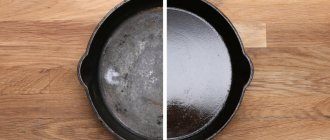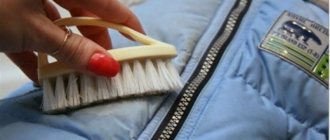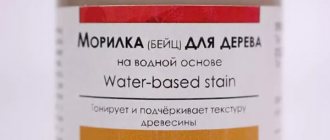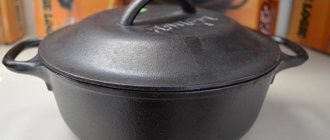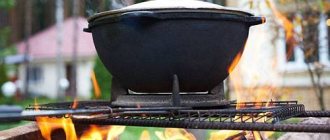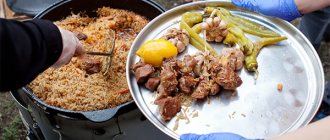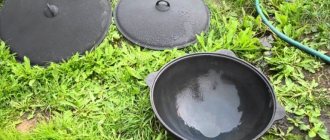So, you bought a cauldron, a good, real, cast iron one (or maybe aluminum, which is also good). Congratulations, this is a worthy purchase that will allow you to cook a wide variety of dishes, tasty and aromatic. But you can’t immediately use the vessel for its intended purpose. Because warehouse storage does not add hygiene to it, and cast iron can rust in places over time (this is not a problem for aluminum, but it also needs to be processed). And on new cauldrons there is an oil film that needs to be removed, because it is machine oil, completely tasteless and non-nutritious. But seriously, it’s simply harmful to humans.
How to treat a new cauldron before use: cast iron
So, the very first thing you should do is heat the new cookware. It is best to do this outdoors, because the calcination process is accompanied by a lot of smoke and unpleasant odors. But, if this is not possible, you will have to heat the cauldron at home in the kitchen - open the windows, turn on the hood and close the kitchen door more tightly. All is ready? We can begin.
The calcination process is simple:
- The cauldron is washed with warm water to remove dust or other contaminants.
- The fire is lit, above average.
- A cauldron is placed on the fire.
That's all. You need to keep the dishes on the fire until not a speck of machine oil remains on the walls. On average, calcination takes an hour and a half. And yes, it is accompanied by unpleasant odors and smoke, don’t be alarmed.
How to check a calcined cauldron
You can understand that calcination has come to an end by a number of signs:
- No persistent unpleasant odor.
- The walls of the dishes will be uniform, without stains and any differences, as well as cracks.
A well-pierced cauldron.
After the first preparation of a dish, it will be noticeable that aluminum utensils are quite suitable for this. No food particles will stick, and everything cooks quickly.
How to treat a new aluminum cauldron?
Yes, just like cast iron. Wash it with warm water, put it on fire, wait until all the engine oil burns out. True, there is one important point: aluminum cookware should not be kept on high heat, the aluminum will simply melt and the cauldron will be damaged. Therefore, aluminum cauldrons are calcined on fire below average, that is, on low.
Oil calcination
After you have burned out all the engine oil, you need to create a new oil film on the walls of the cauldron, this time “edible”. This is done using any vegetable oil. Depending on the volume of the dishes, you will need from 500 ml to a liter of oil. Pour it into a cauldron and place the dishes on a small fire. Cook the oil for about half an hour, periodically tilting the cauldron so that the walls are completely covered with a film. Then the fire is turned off, the oil is allowed to cool and drained, and the cauldron is rinsed with warm water (without detergents) and wiped dry. Then walk along the inner walls with a rag soaked in vegetable oil. That's all, now you can cook. The process is simple, but keep in mind that the oil smokes and can catch fire if handled carelessly.
Rules for firing a cauldron before first cooking
Food casting is fired so that the factory lubricant burns out. It turns into smoke and soot, which is removed with hot water and soap. The procedure for firing a cast-iron cauldron before the first cooking is lengthy and unpleasant: a fair amount of smoke is generated, and it does not smell like roses. Aluminum is processed faster; when working with it, several nuances must be taken into account. There are features of firing a cauldron.
The food turns out much tastier and more aromatic, since such dishes are cleaned of technical grease and undergo a procedure for renewing the protective coating with oil.
Note! Some manufacturers produce cauldrons with a black non-stick coating. This is a thin layer of durable enamel. It is not oily to the touch; when wiping new dishes, no stains remain on the napkin. If you pour water, rainbow stains will not appear on it.
Cast iron
Cast iron products are very heavy. Casting is done with thick walls, thanks to which the products simmer rather than boil or fry. Cast iron must be handled with care. If accidentally dropped, the metal may crack; the alloy is classified as brittle. Below is detailed instructions on how to fire a new cast iron cauldron over a fire and at home, what you will need for this.
Without proper processing, food cooked in a cauldron will simply be inedible and smell bad, and cooking in general will become impossible.
Note! Cast iron is not afraid of temperature contrasts. Previously, cast iron pots were fired in winter, thrown out of the fire into the snow, then wiped dry and put back on the fire. The procedure was repeated several times.
Aluminum
Aluminum alloy, or rather duralumin for casting, is valued for its low specific gravity. But the metal has one peculiarity: when unevenly heated, internal stresses form in it; the cauldron can become deformed if fired over high heat.
How to treat a new cast iron cauldron without oil?
Regular table salt will help. You will need one and a half kilograms of it, take coarse salt. The algorithm is still the same: pour salt into a cauldron, place the dishes on low heat and heat for about an hour. The degree of “readiness” is determined by the color of the salt - it should turn gray. It is clear that this salt should not be eaten.
After cooling, the cauldron should be rinsed, wiped dry and greased with oil using an oiled rag.
Both of these methods are suitable for both cast iron and aluminum cauldrons. In the future, when using dishes, you need to calcinate them after each wash so that the oil film is not removed from the walls - otherwise the food will burn, and the taste will not be the same. In general, many are not too eager to wash the cauldron until it shines, believing that the “native” oil film that forms during cooking only improves the quality of the cauldron. Let’s not argue with this, everyone has their own views. The main thing is that you now know what a new cauldron is, how to process and care for it.
Based on materials from Shelkoviyput.ru
Pilaf, stewed meat - I thought, and my mouth began to water. Tasty! Of course, you can cook these culinary masterpieces in an ordinary saucepan. But in a specialized cauldron, these dishes turn out to be finger-licking.
A cauldron is a saucepan with a round bottom. They are made from cast iron, aluminum, and other metal alloys. But the latter are extremely rare and are often used to decorate the kitchen.
A new cauldron requires the attention of the hostess. Before the first cooking, it needs to be heated. Experienced chefs recommend buying an already used cauldron. So, they say, the dishes turn out tastier, and you can skip the mandatory calcination procedure.
Why experiment with high temperatures? The fact is that metal products - any kind - are poured into molds. To separate a cast iron or aluminum cauldron or pan from the mold, it is coated with a layer of technical oil. As a mistress of the mold when baking cupcakes. If you do not want to enjoy the taste and smell of machine lubricant instead of pilaf, then before 1 use the dishes must be calcined. This will remove any remaining grease.
Myths
For some reason, it is generally accepted that cast iron cauldrons are of higher quality than aluminum ones. But this is nothing more than an exaggeration and not an entirely reliable fact.
They say that aluminum can be harmful to the human body. But purchasing from trusted companies will reduce the risk of harmful particles coming from products made from low-quality materials. Moreover, manufacturers test all materials for quality and comply with safety requirements. And when cooking a cauldron, a special protective film is formed that will protect the food from any impurities.
There is also an opinion that food in a cauldron will be cooked to a lower quality. This opinion is primarily due to the fact that such cookware has a thin layer of metal and it heats up faster, but the temperature is also lost faster. This is just a misconception. You can cook food in an aluminum cauldron very easily, you just need to adapt and choose the right temperature conditions.
Cooking pilaf in an aluminum cauldron.
One more thing. There is an opinion that aluminum cookware is short-lived. This is also a misconception. If it is properly and efficiently prepared, it will last for decades if used correctly.
How to heat a cast iron cauldron?
It sounds complicated, but the process is quite simple. The main thing is to follow the rules and not burn your hands and other parts of the body, and also not burn the kitchen.
There are several ways to heat a cast iron cauldron.
- On an open flame.
New cast iron cookware should be washed with warm water and detergent. Then heat the cauldron over an open fire for 2-3 hours. You can use a gas stove, but it is better to do it in the fresh air. When burned, machine oil emits acrid smoke, so it is better not to use this method indoors.
The signal for the end of the process is the disappearance of dark spots from the surface of the cauldron.
- Over an open fire using rock salt. Indoor method.
For a cast iron cauldron you will need 2 to 3 kg of table salt. Use coarse rock salt; extra is not suitable.
Heat the container over the fire with salt for 1 to 2 hours. The salt should become evenly brown as it will adsorb the engine oil. It should be thrown away.
- Calcination with oil.
This operation is additional after dry calcination. A cast iron boiler tends to rust, so lubrication is still necessary.
Pour 1 liter of oil – olive, cottonseed, sunflower – into a hot cauldron. Wait until the oil boils and carefully tilt the container so that the liquid covers all the walls of the cauldron. Leave on fire for 2 hours.
If the dimensions of the oven allow, then calcination with oil can be carried out in the oven at a temperature of 200 degrees for 2 hours.
After processing, leave the cauldron to cool. Don't pour water into it! Cast iron is a fragile material and cookware can crack. After complete cooling, wash the boiler with warm water and detergent.
Calcination methods
There are several basic options for calcining a cast iron cauldron. All methods are simple. The main thing is to observe safety precautions and strictly follow the instructions.
Oil
Sometimes people call the process of calcination with oil “blueing,” but this is incorrect. In this case, iron oxide does not form, but a smooth film of burnt vegetable oil appears. It will not affect the taste and aroma of the dish in any way and is needed to ensure that the food does not burn during cooking.
Animal fat or vegetable oil is used for roasting. A 10 liter boiler will require approximately 200 ml of oil. The procedure takes about 30 minutes and requires constant human intervention.
How to fire a cauldron:
- It is washed with detergents and then dried. It should be completely dry inside. If necessary, additionally wipe with napkins or paper towels.
- Pour 200 ml of vegetable oil into a cold cauldron.
- The dishes are placed on medium heat.
- The cauldron is tilted in different directions. At the same time, try not to spill oil on the fire. The inner surface can be lubricated using a slotted spoon.
- When the walls begin to dry out, they are lubricated again.
- After calcination is completed, the oil is drained. It can no longer be used.
- Wait until the dishes have cooled completely, then wipe with paper towels to remove oil.
To check the quality of the work performed, pour water into a wiped cauldron and boil it. If it does not become cloudy, then the dishes are suitable for cooking.
Attention! After firing, the container must not be washed with detergents.
With salt
This method is used for firing in apartments when it cannot be done outside. To perform the procedure, use only coarse salt. The larger the crystals, the better. Fine grinding and extra grinding are not suitable.
How to prepare a new cauldron for use:
- The container is washed from the outside and inside under running water.
- All walls are thoroughly wiped with a cloth or napkins.
- 3 kg of table salt is poured into a 10 liter cauldron.
- Place the dishes on the fire and ignite for 1-2 hours.
- The duration is adjusted based on the color of the salt. After firing, it develops a rich brownish tint. The color changes as the machine oil is absorbed.
- After the firing is completed, the inner and outer surfaces are wiped with the same salt.
The salt used to heat the cauldron cannot be used for food. It absorbed a lot of technical oil.
In the oven
It is not advisable to do this procedure. They only bake in the oven if there are no other options. An unpleasant odor will be released during firing. Before calcination, open all windows to ensure a good draft.
How to fire a new cast iron cauldron:
- Preheat the oven to 200°C.
- Pour 25 ml of oil into a cold cauldron. Using a brush, spread it over the entire inner surface.
- Cover the top of the container with foil. This will help keep the oven free of oil.
- The boiler is kept for about 1 hour.
- After this, let the dishes cool and remove excess oil with napkins.
The whole process is repeated 3-5 times.
Outdoors
When processed over a fire, high temperatures are reached, heating the entire surface of the cauldron both inside and outside. The fire must be open; a brazier or other structures should not be used.
How to prepare a cauldron for first use:
- Above the site of the future fire, install 2 supports and a crossbar between them to install the container.
- The cauldron is washed under running water using detergents.
- Rinse thoroughly and allow to dry.
- The container is fired over an open fire for 3-4 hours. At the same time, the fire is constantly maintained.
After processing is completed, the cauldron is cooled naturally. Then rinse under running water.
Important! During processing, a large amount of machine oil vapor will be released. It is better to stay away from the fire to avoid inhaling harmful substances.
How to heat an aluminum cauldron?
An aluminum cauldron is a budget option. This type of cookware costs less than its cast iron counterparts and is much lighter. But aluminum pans heat up quickly and cool down just as quickly, so there won’t be a simmering effect like in cast iron.
Aluminum is a low-melting metal, so you need to calcinate such a cauldron with caution. Since there is a high probability of getting a metal lump instead of dishes.
Currently, aluminum cauldrons with non-stick coating have appeared on store shelves. Such dishes are not heated before use!
The purpose of calcining an aluminum cauldron is to create a film of oxides on the surface. After this, free aluminum will not be able to get into food or react chemically with any ingredient.
- Open flame.
You can heat an aluminum cauldron outdoors over a fire, just like its cast-iron counterpart. But the fire should be below average. It is advisable to use damp firewood that does not produce a high combustion temperature. The duration of the procedure is no more than 1.5 hours.
Aluminum cookware must be carefully monitored during heat treatment. Otherwise, you risk not heating up the boiler, but melting it!
- Using table salt.
The operating principle is the same as with cast iron cookware. But - low heat, and the processing time is no more than 1.5 hours. The salt should turn a creamy brown color.
After calcination, salt cannot be used as it has absorbed engine oil.
- Using vegetable oil or animal fat.
The procedure is the same as when calcining cast iron cookware. But aluminum cauldrons do not rust, since the alloy does not contain iron. Therefore, there is no point in playing with oil! But if you want, then use oil to heat aluminum cookware.
Fire is below average, processing time is 1.5 hours.
Be careful not to burn your hands or other parts of your body!
After calcination, leave the dishes alone until they cool completely. Aluminum does not burst due to temperature changes like cast iron. But it's not worth the risk! Do not wash the aluminum cauldron with abrasives or steel wool. You will damage the aluminum oxide layer. As a result, dishes will begin to burn, and harmful metal will get into the food.
Excess weight is dangerous to health!
Excess weight is not just an aesthetic problem, it is a health problem. Proven by doctors - every 10 kg. Excess weight shortens a person's life by 3-5 years. It has also been proven that everyone can lose weight, all you need is...
With proper care, a cast iron cauldron will last for decades, giving food a unique taste and aroma. How to prepare a cauldron for the first use and care for it in the future?
The classic cast iron cauldron will never go out of use. This is a centuries-tested cookware that allows you to prepare real culinary masterpieces. With proper care, it lasts for decades, giving food a unique taste and aroma. How to prepare a cauldron for the first use? There's nothing complicated about it. You need to act according to the following scheme:
- rinse the cauldron well in warm water with detergents, removing excess technical oil;
- heat the cauldron over high heat until smoke stops coming from it;
- ignite with salt to remove soot and foreign odors;
- add vegetable oil to it and heat it thoroughly so that it is absorbed into the pores.
Everything is quite simple. Below we will describe each point in more detail so that you do not have any questions.
Features of preparing an aluminum cauldron before using it for the first time
Aluminum has disadvantages compared to cast iron cookware, namely, it deteriorates faster and does not keep food warm. But this material also has its advantages. So, it is light in weight, which is especially good when hiking.
By resorting to the above-described recommendations for calcining an aluminum cauldron, you can maintain its operational features for a long time. You just need to remember that it is forbidden to overheat such dishes, since the bottom will become round and the walls will become oval, which will affect the quality of the dishes.
How to prepare a cast iron cauldron for use
Wash the cauldron from factory grease with warm/hot water and non-abrasive detergents. Then dry it with a towel and place it on the stove. Make the flame as high as possible and heat the cauldron for two hours, turning it from side to side. When the oil burns out (the smoke stops), wipe the inside surface with napkins and add a kilogram pack of salt to the cauldron. Heat the dishes for about another hour - during this time the salt will turn gray and draw out everything unnecessary from the material.
The last stage is calcination with oil. Add 300-400 ml of any vegetable oil to the cauldron, place it on medium heat and simmer for 20-30 minutes. The cauldron must be tilted from time to time so that the oil covers the walls (you can use a brush or special paper). Then let the dishes cool and put them in a dry place.
Using oil for calcination
After completely burning out the harmful oil, another film of oil needs to be formed on the walls of the new cauldron. Only vegetable oil is already used.
The volume of your cauldron matters here. Usually a minimum of 500 – 1000 ml of oil is required to cleanse. It is poured into a cauldron. It is placed on low heat for 30 minutes. During such boiling, the cauldron must be periodically tilted so that its walls are completely covered with the required film.
Then the stove turns off. The oil is cooling. It is drained from the cauldron. The cauldron itself should be cleaned with warm water. Detergents must not be used. The dishes are wiped dry. You need to walk along its internal surfaces with a rag previously soaked in natural oil. Your new aluminum cauldron is now ready for use. Please note that if not handled properly, the oil may ignite.
And if you want to purchase an aluminum product that will largely replace the thick-walled cast iron Tatar analogue, the walls of this product must be at least 1 cm thick.
How to care for a cast iron cauldron
Cast iron cookware can last for decades, becoming better with each use. But for this you need to properly care for it. Always proceed as follows:
- After cooking, immediately remove food from the cauldron while it is hot. Then wash it with warm water, without using detergents;
- If you can’t remove the food right away or it’s burnt, then rinse the cauldron using a metal brush. Minimize the use of detergents - they destroy the protective oil layer;
- how to care for a cast iron cauldron if it is covered with rust? In this case, you won’t be able to do without detergents. Wash it and then heat it over high heat with vegetable oil. Heat the cauldron for 10 minutes, periodically “stirring” the oil so that it covers the walls. The dishes are ready to use again!
Proper processing after calcination
After calcination, you also need to use oil treatment. This treatment gives the dishes a protective layer, which prevents food from burning and prevents the formation of rust. Thus, you should use 1 liter of oil, animal or vegetable origin, the main thing is that it simmers well. The cauldron should already be calcined, it is heated and the walls are poured with oil using a kitchen slotted spoon. The process will take about 20 minutes, after which the dishes should cool and the oil should be removed. Then the cauldron is rubbed with paper or a towel.
Dishes with an oil layer should not be washed with detergents; it will be enough to simply rinse them with boiling water and wipe with a soft washcloth.
How to remove an unpleasant odor from a cauldron
Cast iron has one drawback - it absorbs odors well. If you cooked something exotic with it, the smell may persist for 2-3 subsequent cooking sessions. But the smell can be easily removed. To do this, place the cauldron on high heat, pour about a kilogram of salt into it and heat it for 30-40 minutes, stirring regularly and spreading it over the walls. Salt perfectly absorbs odors and removes excess soot. After the procedure, remove the salt, let the cauldron cool slightly, and wipe the inner surface with napkins. Then reheat the pan and grease it with vegetable oil. For lubrication, you can use a regular brush or paper.
How to care for a cast iron cauldron if it is covered with a thick layer of soot on the outside? It needs to be removed. You can use an old knife or spatula for this. If possible, have it sandblasted - it will quickly and carefully remove the burnt layer without damaging the material. After sandblasting, you just need to rinse the dishes in warm water and heat them with oil.
How to care for a cauldron during frequent cooking? Just rinse it in warm water and wipe dry with a towel. You need to store the cauldron in a dry place - moisture can cause it to rust.
Press release prepared by the site
You can cook the most delicious dishes in classic cast iron cookware. If used correctly, it can last for decades. However, not everyone knows that such products require preliminary preparation. After reading today's article, you will learn how to heat a cast iron cauldron.
Care instructions
It is very important to follow a few simple rules to ensure that the aluminum cauldron lasts for many years. These include:
- proper preparation before first use;
- regular cleaning of all contaminants quickly;
- do not leave stuck fat and food residues;
- use only gentle cleaning products without abrasives;
- use silicone or wooden spatulas to avoid damaging the non-stick layer.
By following these simple rules, you can preserve the surface of an aluminum cauldron for a long time.
Existing firing techniques
Let us immediately note that the process of preparing for further operation is quite simple. It involves treatment with fire so that the factory grease disappears from the dishes, and subsequent rinsing with warm water.
Those who are interested in how to heat a new cast iron cauldron should understand that metal scourers and detergents cannot be used during the pre-treatment process. Today there are two methods of firing such products:
- Over an open fire using an outdoor oven or barbecue.
- On a gas stove or in the oven.
It should be understood that the calcination process is accompanied by the release of a large amount of smoke and fumes resulting from burning of the oil. Therefore, if the procedure is carried out indoors, it is necessary to turn on the hood in advance, as well as open doors and windows to provide a draft.
How to properly calcinate depending on the type of metal
Firing cauldrons made of other metals is slightly different from processing cast iron containers. It's all about the material and manufacturing technology.
Aluminum
Aluminum cauldrons also require pre-calcination before the first cooking. The procedure is performed outdoors, as during firing an unpleasant odor and a lot of smoke will be released. When performing the procedure at home, be sure to open the windows and turn on the hood.
Calcination process:
- The cauldron is washed in warm water to remove dust and other contaminants.
- Place on fire. If the operation is performed on a gas stove, use medium flame. In the case of a campfire, the fire must be large.
- The container is sent for firing.
The boiler is kept on fire for 60-90 minutes. During this time, all the engine oil should burn out.
Copper
Nowadays such dishes are used very rarely. The reasons are as follows:
- Copper is susceptible to corrosion.
- The material does not retain the required temperature well, so it will not be possible to simmer the dish in such a container.
- Copper compounds are toxic to humans.
- The container requires careful cleaning after each cooking. This takes a lot of effort and time.
Copper cauldrons are placed on a burner or sent to the fire for 1.5 hours. In this case, the use of vegetable oil or salt is not required.
Steel
Steel cookware is calcined as follows:
- Cover the cauldron with a lid and place on maximum heat for half an hour to completely burn out the machine oil. Do not pour water or oil into a hot pan. The liquid will begin to splash, causing burns. In addition, the oil can catch fire.
- The cauldron is left to cool for 20 minutes. After this, it is thoroughly washed with household chemicals and wiped.
- The container is put back on the fire. 1.5 cups of vegetable oil are poured into it and distributed over the walls.
- Using a slotted spoon, lubricate the walls with oil every 5 minutes.
- After half an hour, the oil will begin to boil away and smoke heavily.
- It is drained, after which the dishes are wiped with napkins.
There are also steel cauldrons that have an enamel coating. Such dishes do not require calcination.
How to heat a cast iron cauldron using salt?
First of all, you need to turn on the gas burner and open the windows. Then pour a whole pack of table salt inside the dish so that it is evenly distributed along the bottom, and place the container on the stove.
The whole procedure will take about half an hour. During this time, it is necessary to periodically stir the salt. As a result, the contents of the cauldron will acquire a grayish tint, indicating that everything is going according to plan. After thirty minutes, pour out the salt and cool the vessel. Then the container should be rinsed with warm water and wiped thoroughly.
After this, the product must be filled with vegetable oil, the amount of which depends on the volume of the cauldron, and sent to the stove operating at medium power. After half an hour, you need to drain the contents of the dish and cool it.
FAQ
Are aluminum cookware harmful?
Why is aluminum cookware better than steel or cast iron?
What is the difference between stamped aluminum cookware and cast aluminum cookware?
Why do you need to heat cast aluminum cookware and how to do it?
Why does the surface of aluminum cookware darken?
On what stoves can Kukmara cookware be used?
Why is the bottom of the dishes pierced?
Can cast aluminum cookware be used in the oven?
Is non-stick coating harmful?
Can I use non-stick cookware if the coating is scratched?
Can I store cooked food in aluminum and non-stick cookware?
Why is cast cookware more expensive than stamped cookware?
At what temperature can you cook food in non-stick cookware?
How to distinguish TM Kukmara from a fake?
JSC “Kukmorsky Metalware Plant” informs that products sold under the guise of Kukmor tableware have appeared on the tableware market, which is misleading consumers. To avoid misunderstandings, we certify that our company is the only manufacturer of cast aluminum cookware and cookware with non-stick coating in the Republic of Tatarstan. The company has been producing products in the city of Kukmor since 1950 and sells them under the Kukmara .
The distinctive sign of the products of Kukmor Metalware Plant JSC is the trademark in the form of the Kukmara , which is present:
at the bottom of each product (trademark certificate No. 611777 dated May 5, 2016)
on glass lids, individual boxes (trademark certificate No. 613028 dated May 5, 2016)
The absence of this distinctive sign on the dishes indicates that the product is not a product of the Kukmor plant, i.e. fake.
Currently, the product range of the Kukmara includes about 900 products and is produced in the following lines:
1. Non-stick cookware:
Source
Creating a non-stick layer
Having figured out how to heat a cast iron cauldron, you need to try to make sure that during the cooking process food does not stick to its bottom. To create a non-stick coating, you need to grease a dry container with a large amount of vegetable oil and place it on a paper towel. To remove drips, you can use napkins.
After getting rid of excess oil, the cauldron must be placed in the oven, preheated to 180 degrees and lined with foil. The container should stand there for three hours. This time is enough for a strong and thin layer to form on the walls of the dish, preventing food from burning.
Having understood how to heat a cast iron cauldron at home, you need to figure out how to extend its service life. In order for such dishes to serve your family well for several decades, you should provide them with proper care.
Don’t forget to transfer still hot food to another bowl, and immediately wash the cauldron itself with warm water without detergent. Burnt residue can be removed with steel wool.
Those who already know how to heat a cast iron cauldron will be interested in figuring out what to do if rust appears on its surface. In this case, the vessel, previously washed and filled with vegetable oil, must be heated over high heat for ten minutes.
One of the main disadvantages of cast iron containers is their ability to absorb any odors. To get rid of a persistent foreign aroma, you need to fill a cauldron with a kilogram of table salt and put it on maximum heat. After thirty to forty minutes, you can empty the contents of the dish, cool it and wipe the inner walls with clean napkins. Then you need to warm up the container again and lubricate it with vegetable oil. To facilitate the process, it is recommended to use an ordinary brush or paper.
If the outside of cast iron cookware is covered with a thick coating of soot, it can be cleaned using an old knife or spatula. If necessary, the product can be sent to a facility that allows you to quickly and accurately get rid of the burnt layer. At the end of this procedure, the cauldron should be washed with warm water and calcined with sunflower oil.
Having read books on cooking pilaf, shurpa, dumlyama and basma, you, full of stomach juices, run to buy a cast-iron cauldron to urgently cook some of the above! Having made the right choice, you rush back to the stove and prepared foods, dreaming of immediately starting gastronomic witchcraft...
Stop! There is absolutely no need to rush! Your new cauldron needs to be properly prepared for cooking. In the process of its production, technical oil is used so that the cauldron is easily and without unacceptable defects separated from the mold, and also does not rust. Of course, machine oil is absolutely not suitable for cooking pilaf! This means it needs to be removed.
There will be a lot of smoke and unpleasant odors during oil removal. It is necessary to ensure good ventilation of the kitchen. Turn on the hood, open the windows, close the doors to other rooms. It is best to carry out the procedure for preparing the cauldron for the first use in the fresh air. Therefore, if you have a dacha or a country house, take your treasure and go there.
Calcination on fire
First, wash the cauldron with warm water. Light or build a fire. The flame should be slightly above average. Place the cauldron on the fire so that it is well heated. The cauldron will begin to smoke and smell unpleasant. It is necessary to ignite over a fire until all machine oil stains disappear. This may take an hour and a half, or even more.
Attention!
If you prefer an aluminum cauldron to a cast iron cauldron, then the calcination procedure should be carried out on fire BELOW average. Otherwise, you risk being left without a cauldron, because... High temperatures can cause an aluminum cauldron to melt.
Oil calcination
The cauldron no longer smokes. Now, depending on the size, pour 400-700 ml of oil into it. This time it’s plant-based, not machine-made. The fire needs to be turned down. Under the influence of oil, the cauldron should acquire a reddish tint. There is no need to heat it up any more. Rotate the cauldron so that the oil covers all the walls, evenly distributed over it. The purpose of the oil is to heat the cauldron as much as possible. Then let the oil cool and pour it out. If you are out of town, it is advisable to turn the cauldron upside down after these steps and hold it over the flame for another 20-30 minutes.
Calcination with salt
After calcination over a fire, you can heat the cauldron not with oil, but with salt. The oil smokes strongly and can even burst into flames if handled carelessly. Pour one and a half kilograms of coarse salt into the cauldron. You also need to heat it for at least an hour until the salt turns gray. Throw away the gray salt.
What methods can you use to properly fire a cauldron?
In the entire history of the existence of cast iron, nothing new has been invented. A cast iron aluminum cauldron is calcined using salt and vegetable oil. The first component retains heat well and absorbs all excess. The second one forms a varnish non-stick film.
There are several types of calcination; you can choose the most suitable one and prepare your kitchen utensils.
Note! If the cauldron comes complete with a frying pan lid, it also needs to be processed. For a regular round lid, salt or dry treatment is sufficient.
With table salt
- The cauldron is placed on the largest burner.
- Fill with coarse salt to a height of up to 3 cm and distribute it evenly along the walls.
- They turn on the fire and wait for the smell of smoke.
- Keep the dishes on the fire for up to 30 minutes.
- The salt is stirred periodically, it will become darker each time (it will absorb the factory grease).
- Leave the cauldron on the stove to cool gradually.
- Pour out dirty salt.
- Wash the inner walls with warm water and laundry soap or mustard powder.
Salt is poured onto the bottom of the vessel and the cauldron is placed on a hot stove or on a fire.
Important! The cauldron is not yet ready for cooking; there is no protective oily film on it. Such cast iron will quickly rust, absorb odors, and begin to smell unpleasant. Creating a non-stick layer is described below.
Oil treatment
The cauldron will require from 300 to 700 ml of oil, depending on the volume. It should cover the bottom by at least 2 cm. During firing, the vessel is constantly turned so that the oil washes all the walls. The processing is carried out over low heat so that the oil does not flare up or smoke too much. Just in case, keep a fire extinguisher nearby. The oil is kept on fire for 40–50 minutes, depending on the size. A large cauldron takes longer to fire.
After this procedure, all remaining contents are drained and the bottom of the container is wiped with a paper napkin.
Important! Hold the cast iron with a regular towel, wrapping it around your hand several times. Mittens are not suitable for hot cast iron, they are too thin. Synthetics will melt immediately.
After the oil has cooled, it is poured down the drain or used for waterproofing impregnation of wood. It is dangerous to use such oil in food, it is almost drying oil. After oil treatment, pour boiling water over the cauldron and wipe dry. You can cook in it!
Thanks to it, food will not burn to the bottom of the cauldron.
Firing in the oven
In an oven preheated to 180 degrees, the cauldron is kept for an hour until the bluish smoke stops oozing from the cracks and the cauldron becomes visible through the glass. It is better to open the oven periodically or turn on the fan mode, if available. You shouldn’t take out hot dishes; it’s better to wait until it cools down completely. Then cool the cauldron and wash it with soap. Dry calcination is only the first stage of cast iron preparation.
Before cooking, you will need to create an oil film on the metal surface.
On an open fire
On a fire, a blowtorch (it is used as a burner), a barbecue, or in an oven, dry firing is carried out without the use of salt and oil. The cauldron is constantly turned over the fire. Where the industrial lubricant burns out, the dishes become grayish and lighter. After all the walls and bottom become uniform, the dishes are thrown from the fire pit onto the grass or into the snow. After this, the cauldron is washed well. Before cooking, it is calcined again, periodically lubricated with vegetable oil.
The procedure is repeated up to 5 times until a dense non-stick coating is formed.
Other rules of care
After the first use of such aluminum cookware, it must be thoroughly cleaned of food residues. Under no circumstances should you soak this cauldron in water with detergents or leave it there for a long period.
It is better to immediately rinse the cauldron with clean water after use and gently wipe it dry with a sponge. This is the safest way to remove stuck food items. Then this dish is almost completely filled with water. The water is boiling. After which it merges. The dishes need to be gently wiped dry again, and then covered with a very thin layer of oil. After these procedures, the cauldron can be stored.
If for some reason your cauldron has been left unwashed for several hours, then food residues will stick to it very strongly. They were either dried out or burnt. There is only one way out - soaking the cauldron. Just do not use chemicals in this procedure. Regular warm water will do.
After thoroughly cleaning the cauldron, household salt (table salt) is placed in it and calcined. This operation takes one hour. The salt should darken and give off a nasty smell. When this happens, it pours into another container. The cauldron cools down completely. Oil is placed in it and calcined. That is, the same operation takes place as when preparing dishes for debut use.
Product features, general care rules
A cauldron is the oldest type of kitchen utensil. A round-shaped dish is a bit like a pot-bellied barrel; it is used for preparing hot, mainly meat dishes - pilaf, shurpa, roast. In everyday life it is often called cast iron. Thanks to the increased strength of the metal walls, the cauldron can be placed both in a classic Russian oven and in a modern oven. The product is also suitable for use in camping conditions, near a campfire.
Such utensils are made of cast iron and aluminum. The first material is quite heavy and massive, the second is light and more convenient to handle. Regardless of the type of raw materials used to make tableware, it requires careful care. General rules:
- Boiling to soften and dissolve scale should last at least twenty minutes, the time may increase depending on the degree of contamination of the product.
- Aluminum cookware must be cleaned inside and out until it acquires a uniform white color, without gray or black spots - carbon deposits.
- Cleaning the cauldron at home using aggressive chemicals is strictly prohibited, as they promote oxidation and subsequent destruction of the metal.
- To simplify further care of the cookware, before the first use, cast iron must be calcined - exposed to high temperatures. In a cauldron treated in this way, food will not burn, and extensive cleaning of the product will be required quite rarely.
Many inexperienced housewives, in search of an answer to how to clean a cauldron from carbon deposits, place it in the dishwasher. If we are talking about a cast iron product, this is strictly forbidden, even if there is no oxide on the dishes, but they are simply contaminated after cooking. Firstly, the equipment does not always have enough power to cope with the greasy surface of the cauldron. Secondly, the chemicals used in the dishwasher can cause corrosion.
A universal way to wash a cauldron: boil some water in a cast iron pot and generously moisten the areas affected by scale, sprinkling them with regular table salt. After this, just cool the water slightly and rinse the dishes - the carbon deposits will come off easily.
Aluminum cauldrons are lighter and more practical
Reviews
Svetlana. Ekaterinburg I bought a 5 liter cauldron especially for my husband. He is my classic hunter. That’s why I gave her a 5-liter aluminum cauldron. We don’t use it at home, but it’s a pleasure to use it outdoors, if you know how to cook and love it. They say that aluminum is not a material for food utensils, but, as I think, a cauldron is made of an alloy. Therefore, when heated, there will be no poison in the food, and even if this is possible, then such a product will not be allowed for sale.
Alexandra Previously, like many people, I had frying pans and pots in my kitchen. But my beloved Muslim husband persuaded me to buy this miracle! The assortment included different cauldrons for different numbers of liters, aluminum and cast iron with a flat bottom and with a convex bottom. And now I just couldn’t be happier!
Peter Pan For a long time I looked closely at various types of cauldrons. I visited more than one store until a colleague advised me to look at OZONE. Paid the next day, the courier stood in front of the door. The first thing that caught my eye, or rather my hands, was how light it was. But at the same time you fry it like in a frying pan, or rather a wok (it has a semicircular bottom). This in turn reduces the amount of fat (oil) needed for cooking. And this is good for both the figure and the stomach.
To summarize, we can say that before choosing a cauldron, you need to decide on the purposes for which you are purchasing it. It is impossible to say with certainty that the best cauldron is cast iron. In addition, the shape, not just the metal, is of great importance. Ball-shaped ones are best used on a fire; models with a flat bottom can be used in any way, but then thin walls of the dishes will be required. Therefore, which cauldron is better, aluminum or cast iron, is up to you to decide.
How to wash?
Just wipe after cooking with a sponge without detergents (the soft part of it and try not to use the hard part of the sponge - this will ruin the oily coating that has been so long and carefully created). If a disaster does happen and the food in the cauldron is burnt, then, of course, you can scrub it with stiffer brushes and steel wool, but again, without detergents. A cleanly washed cauldron is a kind of art!
That any detergent contains chemicals that, having interacted with the oily coating of the cauldron, will settle in it, which, at the very least, can spoil the taste of the prepared dish, as well as harm your health. Using a detergent when washing a cauldron, you will be forced to repeat the process of calcining the cauldron again in order to return it to its original cleanliness and suitability for cooking

